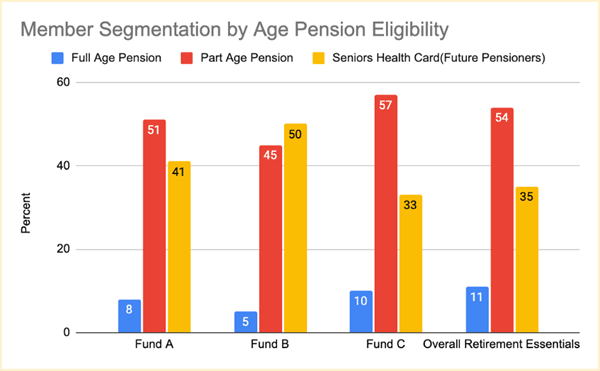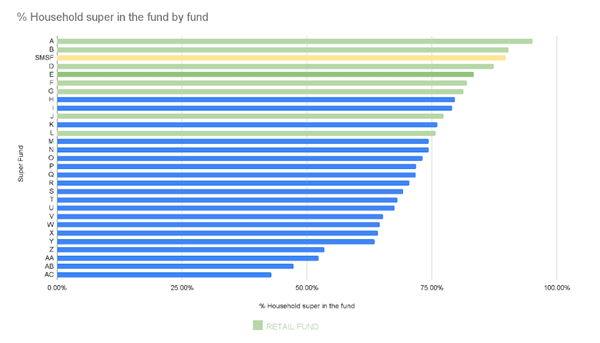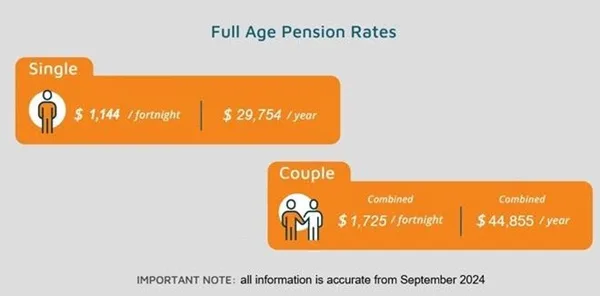
Greetings from SuperEd and Retirement Essentials.
We enclose an update on September’s Age Pension changes. But, first and foremost, let’s talk about leading in retirement.
Leading in Retirement
What does it take for a super fund to lead in retirement? And how can we measure it? APRA and ASIC, in reviewing progress on the Retirement Income Covenant, have stated some strong views about what they’ve observed and found wanting.
In determining leadership in retirement, what type of measures should the industry include and how could funds be ranked to show improvements in a leadership position? A sort of ‘Australian Retirement Income League’ could be a way to show this.
Having a clear picture of what should be measured is important, and just as important is what can be measured.
We have a distinctive vantage point through Retirement Essentials where we help older consumers with the Age Pension and retirement advice topics. The hundreds of thousands of users of our Age Pension Eligibility Calculator and our Age Pension Concierge Service give us a unique insight into retirement at the household level, a view that super funds just don’t have.
If we were to use data to compile a view of retirement income leadership, a sort of “Australian Retirement Income League,” what could we measure?
Measuring leadership
We could start with measures of members’ retirement adequacy — by predicting the likely sustainable household income in retirement. How does it compare with standards such as the ASFA Comfortable Retirement standards? Our Age Pension data gives us enough information to work out what percentage of members are likely to retire at ASFA Comfortable or ASFS Moderate.
It’s also important to understand drivers of retirement sufficiency. There are many factors, some of which are beyond a fund’s control, such as members’ employment income during their working lives and overall market return levels. But funds do influence the member’s outcome through investment decisions and through cost structures. An Australian Retirement Income League could consider those.
Leadership could also involve helping members make the right decisions and avoiding costly errors. For instance, we know that one of the big mistakes members make is to delay their move from accumulation to pension phase, incurring unnecessary taxes on earnings until they switch. Overall, nearly 50% of APRA fund members over 65 are still in accumulation. The aggregate cost of that delay must be in the billions per year. And we know the numbers vary dramatically from fund to fund. This chart shows the results for members of 46 funds using Retirement Essentials data.

You’ll note that retail funds – the green bars have a much lower percentage of over 67s still in accumulation. This likely results from their members being more likely to have received advice.
If you want to know where your fund is ranked, please contact us.
Based on past research with Link Advice, we know that delayed applications for the Age Pension are another large source of loss to members — as there’s no backpay on the Age Pension. Our survey work showed that only 44% applied on time…and 32% admitted to applying at least a year late. A major cause is people don’t understand the Age Pension and need help from their super fund to work it out. We’re now working with 12 of the top 20 super funds through Retirement Essentials and that’s a significant step by those funds to make a difference.
Knowing your members. APRA and ASIC have been very critical of the extent to which funds understand their members and their retirement needs. They have questioned whether funds have enough data to understand their cohorts. Having a useful segmentation model is particularly important to funds developing retirement income strategies.
We think Age Pension eligibility is central to the financial segmentation of older members as the Age Pension is such a strong inflation-protected fixed income component of a retiree’s portfolio. So, we typically break down older members into Full Age Pensioners, Part Age Pensioners and Future Age Pensioners (most of them will be eligible for the Commonwealth Seniors Health Card).
This chart shows the varying results for three of the super funds using our services, compared to the overall client base of Retirement Essentials. It’s very useful to understand your members’ likely entitlements profile.

Member engagement is another factor showing how well funds are supporting their members with retirement. We measure engagement from retirees on a weekly basis, and track members on their engagement levels in retirement content over time.
Engagement levels across funds do vary, and we know that engagement levels improve over time.
Another factor that illustrates engagement of a fund’s membership is household usage of the same super fund. For couples, retirement planning has to be done on a household basis, since the Age Pension is determined that way.
This chart shows the percentage of household super the fund holds…and it varies dramatically from funds which have a very high percentage of the household super to funds that have a low percentage. If I were a fund executive, this would be a key measure for me. I’d want to make sure we were doing our best to win the household. SMSFs and retail funds with adviser distribution seem to have an edge, SMSFs are typically set up to cover the household and as advisers typically recommend the same fund for their clients.

Other components of the Australian Retirement Income League ladder might cover what product and service features the funds are offering – the type of analysis any good competitive comparison would include, such as:
- What are investment options available? How are they invested? What are the fees?
- Does the fund offer a longevity solution, offering the benefits of an Innovative Retirement Income Stream?
- What communications does the fund offer to help members understand the complexities of retirement? How does the fund help members with the transition?
- What advice capabilities –intra fund, digital, hybrid, comprehensive –does the fund provide for the pre-retiree and retire?
- Does the fund help the member with the Age Pension? And other government entitlements?
- Does the fund offer help with broader retirement issues, such as living choices in retirement, Aged Care, estate planning, etc
Leading in retirement is critical to success for members and to success as a super fund. With 6 million people approaching or in retirement, serving and retaining these higher balance cohorts is essential. On the basis that “what gets measured gets done,” it’s high time to be tracking key indicators of retirement leadership.
September Age Pension increases
Keeping you up to date on the latest on the Age Pension. Payout rates and thresholds increase effective September 20, 2024, impacting over 5 million older Australians.
Payout rates
Singles on the full Age Pension can expect a total increase of $28.10 a fortnight and couples can expect a (combined) total increase of $42.40 a fortnight.
That brings the maximum Age Pension and benefits to $29,754 annually for a single and $44,855 for a couple.

Threshold levels
The Income and Assets Tests thresholds also increase. The new levels for singles and couples, homeowners and nonhomeowners are shown in the pictogram below.
Pension disqualifying income limits (per fortnight)
| Family Situation – Resident | Previous Amount | 20 Sep 2024 | Increase |
| Single | $2,444.60 | $2,500.80 | $56.20 |
| Couple (combined) | $3,737.60 | $3,822.40 | $84.80 |
| Illness-separated (couple combined) | $4,837.20 | $4,949.60 | $112.40 |
Pension Disqualifying Assets Limits (per fortnight)
| Family Situation – Resident | Previous Amount | 20 Sep 2024 | Increase |
| Single, homeowner | $686,250 | $695,500 | $9,250 |
| Single, non-homeowner | $938,250 | $947,500 | $9,250 |
| Couple (combined), homeowner | $1,031,000 | $1,045,500 | $14,500 |
| Couple (combined), non-homeowner | $1,283,000 | $1,297,500 | $14,500 |
These increases are good news for older Australians, helping them keep up with inflation.
Our eligibility calculator has already been adjusted to reflect the new rates.
For more information from SuperEd and Retirement Essentials contact:
Jeremy Duffield
jeremy.duffield@supered.com.au
James Coyle
james.coyle@supered.com.au
Jeremy Houghton
jeremy.houghton@supered.com.au

